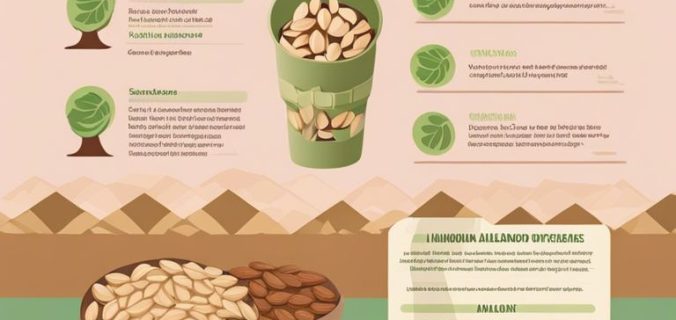Many vegans are unaware of the impact almond production has on the environment. This guide will help you navigate the almond industry to ensure sustainable and ethical practices. From water usage to pollination methods, discover how to make informed choices that support environmental conservation. Let’s probe into the world of almond production and learn how to maximize yield without compromising our planet’s future.
Key Takeaways:
- Diversification is key: Planting other crops alongside almonds can help improve soil health, reduce pest pressure, and provide additional sources of income for farmers.
- Water management is crucial: Implementing efficient irrigation systems and practicing water-saving techniques can help conserve water resources and reduce environmental impact.
- Supporting sustainable practices: Choosing almonds from farms that prioritize sustainability, biodiversity, and ethical farming practices can align with a vegan lifestyle and promote environmental stewardship.
Understanding Almond Types
Before we look into maximizing almond production, it’s vital to understand the different types of almonds available. By knowing the distinctions between sweet, bitter, and blanched almonds, you can make informed decisions to ensure sustainability and productivity.
| Sweet Almonds | Bitter Almonds |
| Blanched Almonds | |
Sweet Almonds
To fully grasp the essence of Sweet Almonds, one must understand the distinctive characteristics and flavor profile they offer. Sweet Almonds are the most common type of almonds found in stores and are typically eaten raw or used in various culinary dishes.
Bitter Almonds
Clearly, Bitter Almonds have a different reputation due to their toxic nature. Bitter Almonds contain cyanide and must be processed properly to remove the toxins before consumption. In fact, ingesting raw Bitter Almonds can be extremely dangerous.
Almonds, in general, are known for their high nutritional content and health benefits. However, it is crucial to handle Bitter Almonds with caution due to their toxic properties.
Blanched Almonds
Now, let’s explore the world of Blanched Almonds. Blanched Almonds are almonds with the skin removed, giving them a softer texture and lighter color. They are often used in baking and cooking where the appearance of the almond is significant.
It is important to note that Blanched Almonds may lose some of their nutritional value during the blanching process, but they still offer a delicious alternative for various recipes.
Factors Affecting Almond Production
Now let’s investigate into the factors that impact almond production and how vegan practices can maximize sustainability. Recognizing these elements is crucial for ensuring a successful harvest.
Climate and Soil Conditions
Affecting almond production, the climate and soil conditions must be optimal for the trees to thrive. Almonds require specific conditions to grow well and produce a high yield.
Irrigation and Water Management
An efficient irrigation and water management system is vital for almond production. This ensures that the trees receive adequate water at the right times, especially in drought-prone regions.
Soil moisture sensors and drip irrigation technology can help almond farmers optimize water usage and reduce waste in the orchards.
Pest and Disease Management
Irrigation and water management also play a crucial role in pest and disease management for almonds. Monitoring moisture levels can help prevent certain diseases that thrive in wet conditions.
For instance, keeping the orchard floor clean and implementing integrated pest management practices can help control pests and diseases sustainably.
Step-by-Step Guide to Sustainable Almond Production
| Planting and Pruning | Fertilization and Pest Control |
| While planting almond trees, ensure proper spacing to allow adequate sunlight and airflow. Pruning should be done annually to remove dead or diseased branches, promoting healthy growth. | Production of organic fertilizers using compost and manure can be beneficial for almond trees. Integrated pest management techniques such as introducing beneficial insects and using pheromone traps can help control pests sustainably. |
Planting and Pruning
While planting almond trees, ensure proper spacing to allow adequate sunlight and airflow. Pruning should be done annually to remove dead or diseased branches, promoting healthy growth.
Fertilization and Pest Control
Production of organic fertilizers using compost and manure can be beneficial for almond trees. Integrated pest management techniques such as introducing beneficial insects and using pheromone traps can help control pests sustainably.
For instance, using organic compost and manure improves soil health and provides crucial nutrients to almond trees without the use of chemical fertilizers. Introducing beneficial insects like ladybugs can help control aphids naturally, reducing the need for pesticides.
Harvesting and Processing
Step-by-step harvesting involves shaking almond trees to release nuts from their shells, which are then collected and dried. The processed almonds can be stored in a cool, dry place or further processed into almond milk or butter.
Guide to sustainability in harvesting includes timing the harvest to avoid rainfall, which can impact nut quality, and utilizing eco-friendly processing methods to reduce waste and energy consumption.

Tips for Maximizing Almond Yield
All almond farmers aim to achieve the highest yield possible from their orchards. Here are some tips to help you maximize your almond production:
- Crop Rotation and Intercropping: Rotate your almond trees with leguminous crops such as clover to improve soil fertility and reduce pest infestations. This will help maintain a healthy orchard ecosystem.
Crop Rotation and Intercropping
The key to successful almond production lies in the health of the soil. By implementing crop rotation and intercropping techniques, farmers can improve soil fertility and reduce the risk of pest outbreaks, leading to a more sustainable and productive orchard.
Mulching and Cover Cropping
Mulching is the practice of covering the soil around almond trees with organic material such as straw or compost. This helps retain moisture, suppresses weeds, and improves soil health. Cover cropping involves planting a temporary crop between almond trees to improve soil structure and fertility.
Cover cropping is an effective way to prevent erosion, enhance nutrient cycling, and provide habitat for beneficial insects in the orchard. By incorporating cover crops into your management practices, you can promote a more diverse and resilient ecosystem in your almond orchard.
Integrated Pest Management
On almond farms, integrated pest management (IPM) strategies are crucial for controlling pest populations while minimizing the use of chemical pesticides. By combining cultural practices, biological controls, and monitoring techniques, farmers can safeguard their orchards from pest damage in an environmentally friendly and sustainable manner.
Cropping practices that promote biodiversity and soil health can help reduce the prevalence of pests by creating a more balanced ecosystem where beneficial insects can thrive. By adopting IPM strategies, almond farmers can protect their yield while minimizing environmental impact.
Weighing the Pros and Cons of Almond Production
Many factors need to be considered when evaluating the sustainability of almond production. By analyzing the pros and cons of this industry, we can make informed decisions about supporting almond cultivation and consumption. Here is a breakdown of the key points:
| Pros | Cons |
| Environmental Benefits | Water Usage |
| Economic Contribution | Pesticide Use |
| Social Responsibility | Habitat Destruction |
Environmental Impact
You can learn more about the environmental impact of almond production by visiting the California Almond Stewardship Platform. This platform provides valuable information on sustainable farming practices and their benefits for the environment.
Economic Benefits
Almond production offers significant economic benefits to farmers, suppliers, and local communities. The industry contributes to job creation, export revenue, and overall economic growth in almond-producing regions.
Benefits: The economic benefits of almond production extend beyond financial gain. By supporting local economies, almond farming helps create sustainable livelihoods and opportunities for growth in rural areas.
Social Responsibility
Social responsibility is a key aspect of almond production, as ethical practices and community engagement are necessary for the industry’s long-term viability. Almond farmers are committed to upholding high standards of social responsibility and contributing positively to society.
Responsibility: Almond producers prioritize fair labor practices, community development, and environmental stewardship as part of their commitment to social responsibility. By supporting ethical almond production, consumers can contribute to a more sustainable and socially responsible food system.
Final Words
So, by following the tips and practices outlined in this guide, vegans can play a crucial role in maximizing almond production sustainably. From choosing organic almond products to supporting farmers who use regenerative agriculture methods, every decision can make a positive impact on the environment. By adopting sustainable practices, vegans can further their commitment to promoting a more ethical and eco-friendly food system.
FAQ
Q: Why should vegans be interested in maximizing almond production?
A: Almonds are a popular source of plant-based protein and vital nutrients for vegans. By maximizing almond production, vegans can contribute to sustainable agriculture and reduce their environmental impact.
Q: How can vegans maximize almond production in a sustainable way?
A: Vegans can support sustainable almond production by choosing organic almonds, buying from local farmers, and avoiding almonds that contribute to deforestation or water scarcity.
Q: What are some tips for vegans to ensure the sustainability of almond production?
A: Vegans can reduce food waste by storing almonds properly, supporting fair labor practices in the almond industry, and advocating for policies that promote sustainable agriculture and water conservation.

